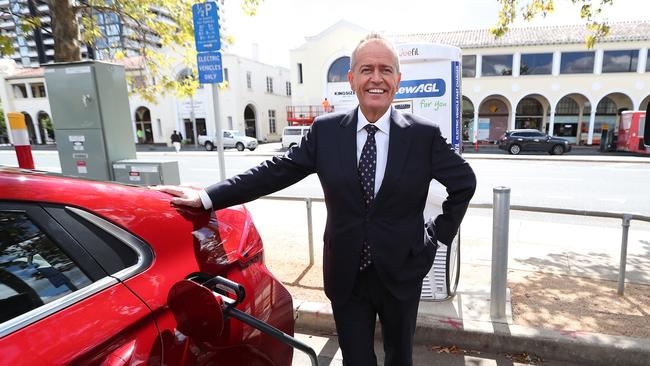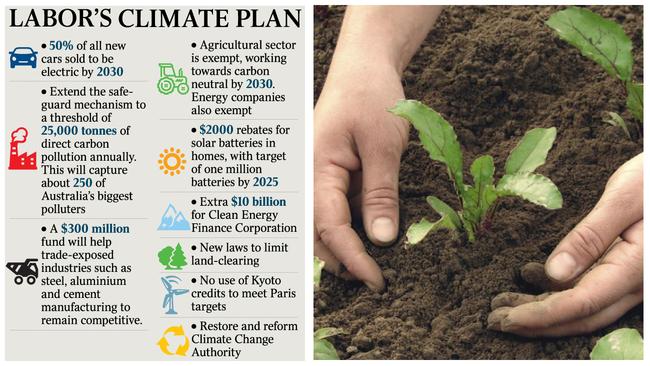No climate for emissions policy change
Businesses are quietly nervous about Labor’s emissions policy.

At the height of political drama over the national energy guarantee in June last year, the Business Council of Australia met other peak industry groups to plan their strategy.
Miners, farmers and business all agreed that Labor was seeking too much, too fast, in its desire to push past the Coalition target of a 26 per cent cut in carbon emissions by 2030.
As she left one meeting, BCA chief executive Jennifer Westacott didn’t wait for the release of a joint, agreed statement. Instead she fired off a tweet: “The emissions target of 26 per cent is appropriate and achievable. 45 per cent is an economy wrecking target.”
Across the following months Westacott’s “economy wrecking” tagline was picked up by the federal government and rammed home in sound bites that highlighted Labor’s “reckless target”, “tremendous cost”, “damaging jobs”, “damaging the economy”, and “wrecking ball”.
As the ALP prepared to launch its climate policy on Monday, another plan was being hatched to neuter the BCA in its ability to make a strident response.
The assault was launched not by the ALP but by national environmental group the Australian Conservation Foundation.
The ACF said Westacott’s “economy wrecking” tweet had been held up by senior government ministers as an authority on the business community’s official sentiment towards climate change action and used to stoke electoral anxiety over the purported economic impacts of a transition to cleaner energy.
“And it has of course most recently contributed to framing the Coalition’s entire national climate policy for the next federal election,” the ACF said.
The environment group pledged to hold the nation’s peak business body and its member companies, representing some of the biggest corporate heavyweights in the country, to account.

Criticism was muted
When Labor’s policy announcement came on Monday, the day before the federal budget, the phrase “economy wrecking” did not pass the BCA’s lips. Instead, the BCA “welcomed” the further detail provided by Labor, which it said clarified some but not all of the unanswered questions about its climate and energy policy.
This was despite the fact BCA member companies had been put firmly in the firing line.
Scott Morrison said the ALP plan would impose a “massive tax” on a swath of Australian companies. Included on the Prime Minister’s list were Coca-Cola Amatil and Telstra, which had been targeted by the ACF campaign against the BCA.
Morrison said the additional burden came from a redrafting of the existing safeguards mechanism to cover companies with smaller emissions levels. The safeguards mechanism sets a cap on pollution for big emitters, but at present there are limited penalties for companies that miss the target.
This would be expected to change under Labor, with the caps lowered and companies expected to buy permits from local or international schemes to cover their carbon position.
Labor says it will work with industry to extend coverage to a threshold of 25,000 tonnes of direct CO2 pollution annually, and it will consult with industry on this coverage threshold and how it is phased in. It is estimated about 250 of Australia’s biggest industrial companies would be captured by the new threshold.
Labor will allow for businesses to earn credits for reducing pollution below their baselines.
There will be special treatment for trade-exposed industries, including a strategic industries taskforce and $300m industries reserve fund to support industries in finding solutions to cut pollution and remain competitive.
The offsets challenge
Crucial to business being able to meet strict new targets will be the development of a well-functioning offset market.
Currently, a business facility that emits more than its baseline must make up for its excess emissions by purchasing offsets, primarily from the land sector.
Carbon credits from land projects have enjoyed a measure of bi-partisan support, first through Labor’s Carbon Farming initiative and then through the Abbott-era Emissions Reduction Fund, which has been renamed the Climate Solutions Fund. Companies can buy the carbon permits issued to projects to offset their emissions.
Aside from the federal government’s reverse auction plan under the Emissions Reduction Fund, the purchase of permits by industry has been voluntary.
Labor says it will make it easier for covered businesses to meet any offset obligations if emissions fall below baselines. It will allow the purchase of some international offsets by companies and potentially a new category of emissions permits from the electricity sector.
It also will reboot the Rudd-Gillard era Carbon Farming Initiative, including the development of “premium” land sector credits to provide alternative and substantial environmental, biodiversity and other co-benefits.
It is a trend mirroring what is happening internationally, with a UN program developed primarily to avoid the destruction of equatorial forests.
Wilderness Society national campaign director Lyndon Schneiders says Labor’s climate policy recognises that reducing emissions and dealing with climate change requires a whole-of-government approach.
“It is a transformation that involves the whole of the economy and the whole of society,” Schneiders says. “Labor’s policy speaks to the reality of how big the challenge is. The missing point has been how they are going to integrate the different areas.”
According to Schneiders, inclusion of national curbs on land clearing has been a missing link: “Our criticism of the Coalition’s Direct Action approach has been carbon dioxide savings achieved through reverse auctions have been lost to increases in land clearing, particularly in Queensland.” Schneiders argues the achilles heel for conservative governments on climate has been their inability to move the Nationals on curbing tree clearing.
A crucial part of Labor’s policy for land clearing is to develop a national database for Queensland’s Statewide Landcover and Trees Study. SLATS uses satellite imagery to monitor woody vegetation clearing in Queensland.
The system is being used to monitor the state government’s new laws, which are expected to halve clearing rates in Queensland from its present peak of about 295,000ha a year.
Extending SLATS nationally sets up a big political contest.
Current criticism of SLATS is that it does not properly account for regrowth.
Extension of SLATS will have big implications for Western Australia and the Northern Territory in particular because little is know about current rates of clearing in those areas.
By exempting Queensland, federal Labor has put the spotlight on the new clearing and forestry practices in NSW.
Fundamentally, the clearing issue rests on how to deal with property rights and whether compensation should be paid to landholders.
Federal Agriculture and Water Resources Minister David Littleproud says Labor’s approach would punish farmers for managing vegetation.
“If Labor is getting carbon gains from stopping farmers making money on part of their farms then it should pay compensation,” Littleproud says.
“Taking away part of a business’s assets and offering nothing in return is wrong.”
Sunny side up for Labor
On power, the ALP policy is sticking with planned giveaways on household solar as it attempts to develop an acceptable national energy guarantee.
With almost two million Australian households already having installed solar panels, Labor will offer $2000 rebates for solar batteries for 100,000 households.
It has set a target of one million batteries by 2025.
Labor says its battery subsidy will support the target of 50 per cent renewable energy by 2030, but there is little real detail on how this will be achieved.
In transport, Labor has proposed tough new emissions standards and set a national electric vehicle target of 50 per cent of new car sales by 2030.
Few details have been given, but promoting electric vehicles almost certainly will involve subsidies while the cost of existing popular vehicles most certainly will rise.
One immediate political contest set up by Labor’s plan is over the use of carryover permits from the earlier Kyoto Agreement period. Unlike many other countries, Australia has exceeded the carbon savings it promised under Kyoto mark two, which covers developed countries until the Paris Agreement kicks in in 2020.
The federal government has said it will use the extra Kyoto credits to help meet its 2030 Paris Agreement target.
Modelling by the former head of the Australian Bureau of Agricultural and Resource Economics, Brian Fisher, says the use of extra Kyoto credits and international permits are crucial to meeting Australia’s Paris targets at lowest cost.
Labor says by allowing the carryover of Kyoto credits, the Liberals’ target effectively falls from 26 per cent to 16 per cent reduction over 2005 levels. “Using Kyoto credits is taking fake action on climate change,” Labor says.
Questions need answers
In its response to Labor’s recently announced policies, the BCA says several questions remain unanswered.
These include what mechanism will drive and manage the transition to lower-emissions electricity generation to meet Labor’s proposed 50 per cent renewable energy target, and whether a disproportionate share of the national emissions reduction challenge will fall on certain sectors of the economy given that some industries will be excluded from the safeguards mechanism.
The BCA also has sought more detail on the reasoning behind excluding Australia’s carryover permits from Kyoto round two.
“We are pleased to see confirmation that the Labor Party will allow access to limited international permits to help achieve its ambitious emissions reduction target and ensure businesses acquit their emissions liability at least cost,” the BCA says.
“We also look forward to working with the Labor Party over the coming months to clarify the eligibility and amount of international offsets.”
However, the BCA says linking Labor’s ambitious emissions reduction target to the safeguard mechanism “will require significant and challenging reductions for industry”.
“In the context of uneven global commitments to reduce emissions, the Business Council emphasises the need to maintain the international competitiveness of Australia’s trade exposed sectors,” the BCA says.
It has been a subdued response from the Business Council, given the high stakes.
Labor’s whole-of-government approach may look good on paper but critics argue there is a lot of detail still missing on how it can be put into practice.




To join the conversation, please log in. Don't have an account? Register
Join the conversation, you are commenting as Logout